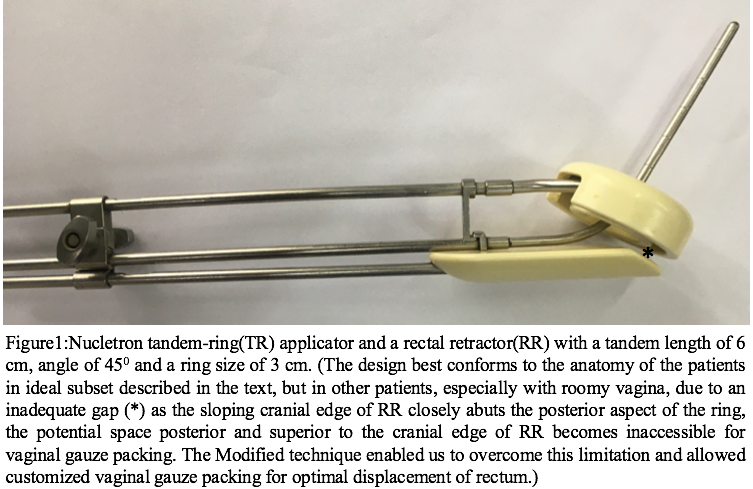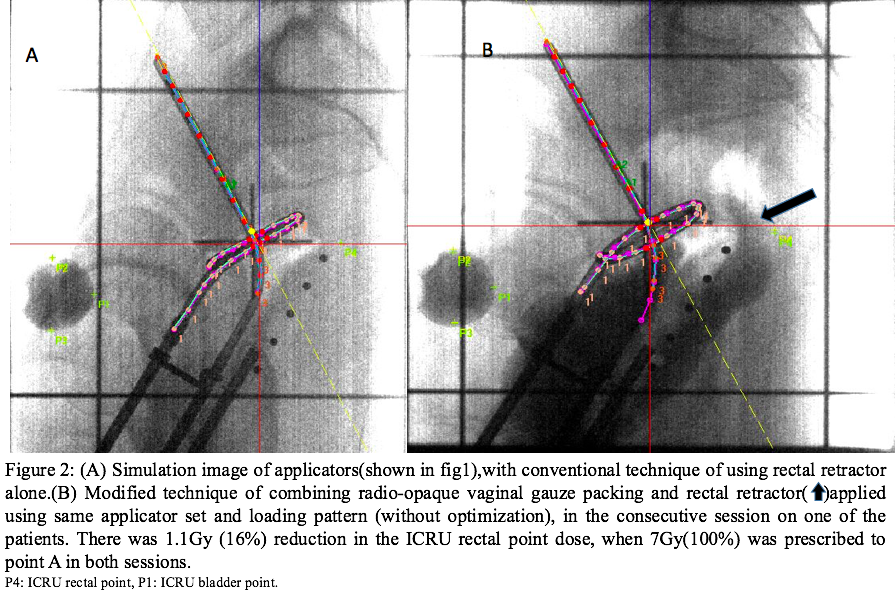A packing technique for enhanced rectum sparing during HDR brachytherapy in cancer cervix.
PO-2137
Abstract
A packing technique for enhanced rectum sparing during HDR brachytherapy in cancer cervix.
Authors: Siddharth Vats1, Shabnum Thakur1, Manish Gupta1, Lalit Chandrakant1, Vikas Fotedar1, Purnima Thakur1, Deepak Tuli1
1IGMC Shimla, Radiotherapy and Oncology, Shimla, India
Show Affiliations
Hide Affiliations
Purpose or Objective
The capacity of the vagina varies from patient to patient at the time of intracavitary brachytherapy (ICB). At one end of the spectrum, there are patients with roomy vagina, and at the other end, there is a subset of patients with narrow vagina and shallower fornices. Patients in this subset are ideal for tandem-ring (TR) applicators (Figure1). But in practice, their use is not restricted to the ideal subset of patients. During conventional ICB procedure using TR applicators, after assembling a rectal retractor blade (RR), the remaining space in the posterior fornices becomes inaccessible. This modified technique enables us to overcome this limitation and makes customised vaginal gauze packing (VP) possible for a range of spaces, posterior and superior to RR, in different patients. This helps to supplement the displacement achieved with RR alone especially in patients with roomy vagina. We compare the standard International Commission on Radiation Units and Measurements-38 (ICRU-38) rectal and bladder point doses with the modified technique of combining radio-opaque VP and a RR versus the conventional technique of using RR alone during HDR-ICB with TR applicators. 
Material and Methods
Between January 2021 and August 2022, 44 cervical cancer patients were treated with at least one ICB session with the conventional technique of using RR alone with TR applicators (Figure 2A), followed by at least one with the modified technique of using a combination of radiopaque VP and a RR, repeating the same applicator set and loading pattern (Figure 2B). The remaining ICB sessions, if any, were done using that applicator-type and packing technique, which gave the best dosimetric parameters during previous sessions in that particular patient. Out of total 111 ICB sessions with TR applicators, 44 in which RR alone was used constitutes conventional group and 67 in which a combination of radio-opaque VP and RR was used for rectum displacement constitutes modified group. 
Results
For the same dose (100%) prescribed to point A in both groups, the mean dose to the ICRU rectal point was 44.1% of the prescription dose (range, 23.8-77.8%; median 42.5%) in the RR+VP group and 55.5% (range, 36.4-73.1%; median 56.5%) in the RR group. There was 11.5% reduction in mean dose to the ICRU rectal point (p<0.001). The mean dose to the ICRU bladder point was 55.5% of the prescription dose (range, 14.8-127.2%; median 55.5%) in the RR+VP group and 49.8% (range 11.6-95.6%; median 51.5%) in the RR group. There was 5.7% increase in the mean dose to the ICRU bladder point (p=0.21). The other point doses and volume parameters were similar between groups.
Conclusion
Modified technique of combining radio-opaque vaginal packing and a rectal retractor, significantly reduced the ICRU rectal point dose, compared to using a rectal retractor alone during brachytherapy with tandem-ring applicators.